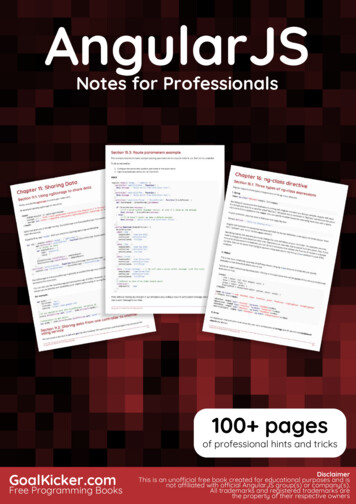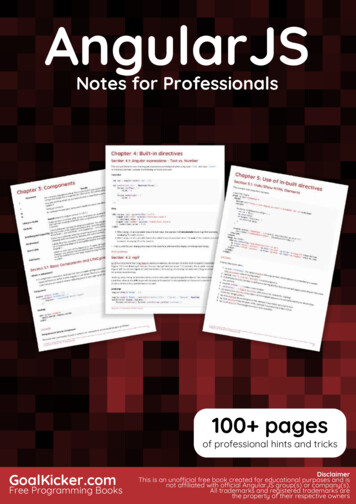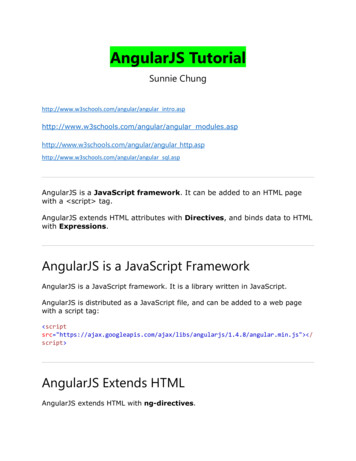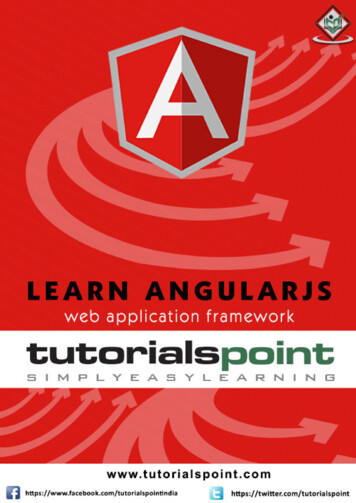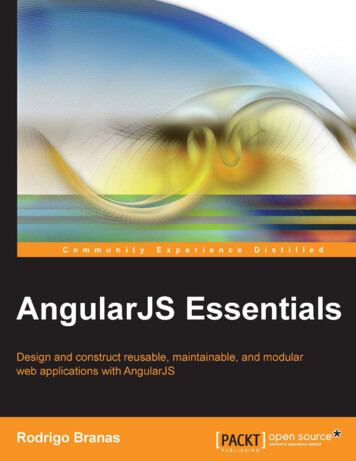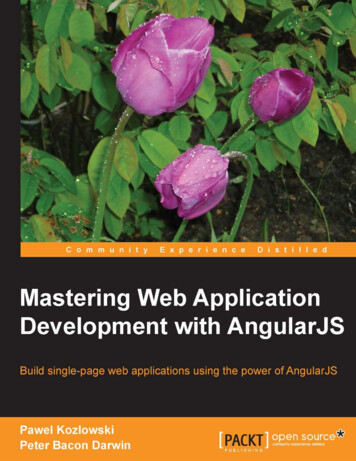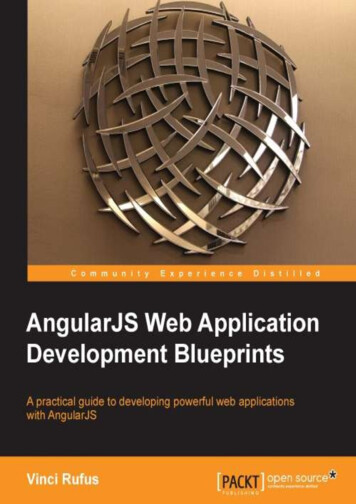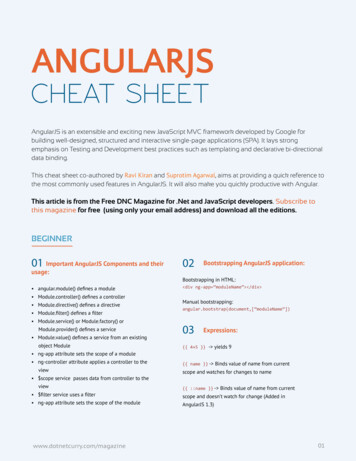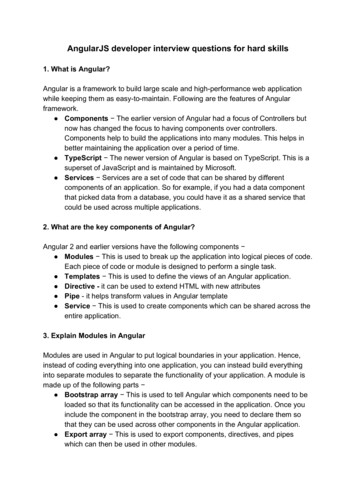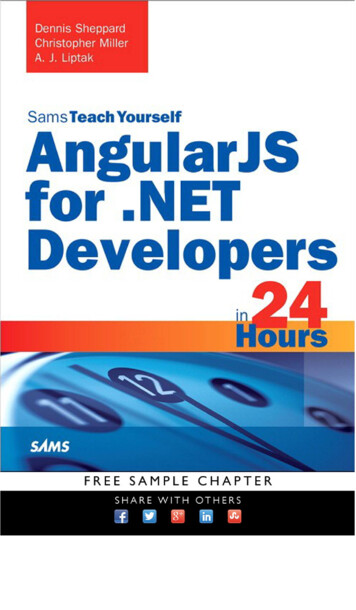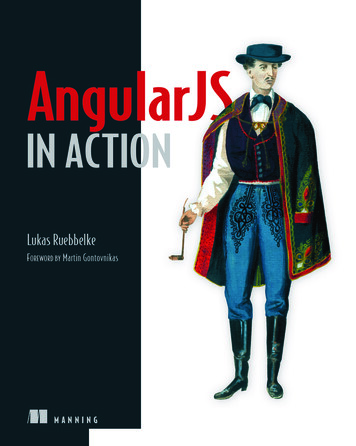
Transcription
IN ACTIONLukas RuebbelkeFOREWORD BY Martin GontovnikasMANNING
AngularJS in ActionLicensed to Mark Watson nordickan@gmail.com
Licensed to Mark Watson nordickan@gmail.com
AngularJS in ActionLUKAS RUEBBELKEwith BRIAN FORDMANNINGShelter IslandLicensed to Mark Watson nordickan@gmail.com
For online information and ordering of this and other Manning books, please visitwww.manning.com. The publisher offers discounts on this book when ordered in quantity.For more information, please contactSpecial Sales DepartmentManning Publications Co.20 Baldwin RoadPO Box 761Shelter Island, NY 11964Email: orders@manning.com 2015 by Manning Publications Co. All rights reserved.No part of this publication may be reproduced, stored in a retrieval system, or transmitted, inany form or by means electronic, mechanical, photocopying, or otherwise, without prior writtenpermission of the publisher.Many of the designations used by manufacturers and sellers to distinguish their products areclaimed as trademarks. Where those designations appear in the book, and ManningPublications was aware of a trademark claim, the designations have been printed in initial capsor all caps.Recognizing the importance of preserving what has been written, it is Manning’s policy to havethe books we publish printed on acid-free paper, and we exert our best efforts to that end.Recognizing also our responsibility to conserve the resources of our planet, Manning books areprinted on paper that is at least 15 percent recycled and processed without the use of elementalchlorine.Manning Publications Co.20 Baldwin RoadPO Box 761Shelter Island, NY 11964Development editor:Technical development editor:Copyeditor:Proofreader:Technical proofreader:Typesetter:Cover designer:Cynthia KaneLeonardo CassaraniBenjamin BergKatie TennantRichard Scott-RobinsonGordan SalinovicMarija TudorISBN 9781617291333Printed in the United States of America1 2 3 4 5 6 7 8 9 10 – EBM – 20 19 18 17 16 15Licensed to Mark Watson nordickan@gmail.com
To my father, Daniel Ruebbelke,who is the foundation of my lifeLicensed to Mark Watson nordickan@gmail.com
Licensed to Mark Watson nordickan@gmail.com
brief contentsPART 1PART 2GET ACQUAINTED WITH ANGULARJS .11 Hello AngularJS32 Structuring your AngularJS application20MAKE SOMETHING WITH ANGULARJS .333 Views and controllers354 Models and services5 Directives6 Animations7 Structuring your site with routes8 Forms and validations5780115130142APPENIDXES .153A Setting up Karma153B Setting up a Node.js server 158C Setting up a Firebase serverD Running the app160162viiLicensed to Mark Watson nordickan@gmail.com
Licensed to Mark Watson nordickan@gmail.com
contentsforeword xiiipreface xvacknowledgments xviabout this book xviiabout the authors xxabout the cover illustrationxxiPART 1 GET ACQUAINTED WITH ANGULARJS .11Hello AngularJS 31.1Advantages of using AngularJS1.2The AngularJS big picture1.3Build your first AngularJS applicationThe module 10Directives 171.42Summary 46Views and controllers711 18Structuring your AngularJS application 202.1Hello Angello202.2AngularJS application structure23ixLicensed to Mark Watson nordickan@gmail.com Services15
xCONTENTS2.3Laying the Angello foundation2.4Basic routes and navigation2.5A few best practices2.6Summary25263031PART 2 MAKE SOMETHING WITH ANGULARJS.333Views and controllers 353.1The big picture363.2What is an AngularJS view?3.3What is an AngularJS controller?The digest cycle 40events 423.4 39Controller as syntax 41Properties and expressionsDisplay stories with ngRepeat4383.5Best practices and testing3.6Summary AngularJS Expressions4343 Filters46485456Models and services 574.1What are models and services? 58Hello services 59of services 604.2The service lifecycle Models with http59 63What is http? 63 Create your first model http convenience methods 6564 4.3PromisesThe different types67What are promises? 68 Promises in action 68 http.successand http.error 69 Elegant sequencing with promises 70 4.4 http interceptorsWhy intercept?4.571 Service decoratorsWhy decorate?4.67173Interceptors in action73 Enhanced loggingTesting considerationTesting a service737575Using httpBackend to mock server calls 764.7Summary72 Best practices 7878Licensed to Mark Watson nordickan@gmail.com
xiCONTENTS5Directives 805.1Introduction to directivesWhat are directives? 80want directives 815.280Why we need directives 81 Directives 101: a quick foundation Why we81The user story directive 825.3A more advanced feature 87The drag-and-drop feature 87 Use the drag-containerdirective 89 Build the controller 90 Create the dropcontainer directive 92 Use the drop-container directive 93Build the controller 94 Create the drop-target directive 100Use the drop-target directive 102 Build the controller 102Create the dragging service 103 Update theStoryboardCtrl 104 5.4Integrating with third-party libraries again! 106Install Flot 106 Build the directive 107 Use thedirective 107 Massage our data 107 It’s time we had the“isolated scope talk” 109 Grand finale: breathe life into Flot 110 65.5Testing a directive5.6Best practices5.7Summary112113114Animations 1156.1Intro to animations115How AngularJS handles animations 116 The animationnaming convention 116 Animations enable! 117 6.2CSS transitions118Define the base transition 118 Define the ng-entertransitions 118 Define the ng-leave transitions 119Making it move 119 6.3CSS animations121Define the base animation classes 121keyframes 121 Make it move 124 Define the animation 6.4JavaScript animations124Defining the JavaScript animation 125 The JavaScriptanimation events 126 The JavaScript animation class 126TweenMax 127 Making it move 127 6.5Testing128Licensed to Mark Watson nordickan@gmail.com
xiiCONTENTS76.6Best practices6.7Summary128129Structuring your site with routes 1307.1The components of AngularJS routes7.2How to create routes in AngularJS131132Create your first route with ngRoute and ngView 132 AddngView 132 Set up your route with routeProvider 132Set up route navigation 134 Review 134 7.3Using parameters with routes135Review 1377.4Using resolve with routes137Review 1387.5Route events139Review 13987.6Testing1397.7Best practices7.8Summary140141Forms and validations 1428.1The big picture: AngularJS form validation143Extending HTML form elements 143 Adding validations 144Form validation and CSS 148 Form validation, setPristine,and setUntouched 149 8.2Testing8.3Best practices8.4Summaryappendix Aappendix Bappendix Cappendix D149152152Setting up Karma 153Setting up a Node.js server 158Setting up a Firebase server 160Running the app 162index163Licensed to Mark Watson nordickan@gmail.com
forewordI realized how awesome Lukas was the day we met at ng-europe. After the conference,we started talking more and I participated in a hackathon he organized, and the otherway around. The one passion we share, and what has brought us together, is helpingpeople build awesome stuff. I know for a fact that was the reason he decided to writethis book. Not for him, but for you!AngularJS is quickly becoming one of the front-end frameworks to use. It’s also oneof the most rapidly changing frameworks out there. In this book, you’ll learn how youcan build an exciting application from top to bottom with AngularJS, while learningwhat controllers, templates, directives, services, factories, and providers are. Instead ofan extensive in-depth guide to Angular’s features, in this book you’ll get a quickglance at what they are and then get your hands dirty so you can learn by using them!You’ll learn not only how to code this application, but also how to test it.Angello is the exciting application—it uses some of the most interesting librariesout there for AngularJS. It’s a project management tool very similar to Trello.Throughout the book, you’ll learn how to implement the different pieces of thisapplication, and how to use ui-router, Auth0, and Firebase, among others.I know you’ll find this book really useful. Happy hacking!MARTIN GONTOVNIKASDEVELOPER ADVOCATE, AUTH0xiiiLicensed to Mark Watson nordickan@gmail.com
Licensed to Mark Watson nordickan@gmail.com
prefaceNever in my wildest dreams did I think that I would be an author, and yet here I am. Ivividly remember the panic that I felt as I clicked “Publish” on my first WordPress poston AngularJS. It felt like I was pressing the launch button for a series of missiles, and Ihad no idea where they would go! Little did I know that I had in fact released a seriesof missiles that would change my life in the most profound and unexpected ways.The moment I decided that I cared more about being helpful than being perfectwas one of the most important turning points of my life. Beginning with a series ofbarely passable blog posts, by accepting every opportunity to implement feedback Igradually grasped what it takes to write a solid blog post. It was also during that timethat I had the opportunity to become friends with the AngularJS core team. AngularJSat the time was still relatively unknown, and so it was much easier to get on their radarthan it is now. Lucky me!I’ll never forget that afternoon when I got the email asking if I was interested inwriting this book. When I was pretty sure that no one was looking, I would break outinto this little happy dance for days. If only my high school English teacher could seeme now!From that moment, I have considered it a great privilege to share with you thethings I’ve learned while building some large applications and writing untold lines ofAngularJS code. It’s been a most excellent journey, and I thank each and every one ofyou for making this possible!LUKAS RUEBBELKExvLicensed to Mark Watson nordickan@gmail.com
acknowledgmentsThis book wouldn’t have been possible without the input and support from the amazing AngularJS community. I want to thank Brad Green, Igor Minar, Miško Hevery, BrianFord, and Matias Niemela for their friendship and for setting such a great example ofwhat it looks like to build awesome things. I would also like to thank Jeff Whelpley, Brandon Tilley, Omar Gonzalez, Martin Gontovnikas, Joe Eames, and about a hundredother people for their feedback. They helped me craft Angello and the book that’s builtaround it. I would also like to thank Geoff Goodman for his contributions on the awesome drag-and-drop example. And I owe Jonathan Garvey a huge debt of gratitude forhelping me get this book over the finish line. You are holding this book right nowbecause of his help and tough love. Special thanks to Martin for penning the forewordto the book, and to Brian for his contributions at the beginning of the project.I especially want to thank my saint of an editor, Cynthia Kane, for her infinitepatience, for helping me to become a better writer, and for sometimes nudging me todo things I didn’t want to do—like write! Thanks also to everyone else on the Manning team who worked with me during the development and production of the book.Many people read early drafts of the manuscript and sent in corrections and comments as it was being written, including numerous MEAP (Manning Early Access Program) readers, as well as the following reviewers: Ahmed Khattab, Brian Cooksey,Chad Davis, Daniel Bretoi, Fernando Monteiro Kobayashi, Gregor Zurowski, JeelaniShaik, Jeff Condal, Jeff Cunningham, Richard Scott-Robinson, Robert Casto, RobertoRojas, and William E. Wheeler. Thanks to all, with a special acknowledgment to technical proofreader Richard Scott-Robinson, who checked the code and read the manuscript one last time, shortly before it went into production.xviLicensed to Mark Watson nordickan@gmail.com
about this bookThe goal of this book is to equip you, the reader, with an arsenal of practical techniques that you can use in the real world—to help you build a non-trivial web application from the ground up, and offer commentary on the most pertinent pieces. Thesample application presented in the book, Angello, comes with a fully functional backend in either Firebase or Node.js with a few extra bonuses such as social logins withAuth0.We had to make some hard decisions about what we were going to cover in thebook and, more importantly, what we would not cover. It would have been easy to godown a rabbit trail as we tried to explain AngularJS on a molecular level, but the actualapplication of this knowledge is relegated to edge cases at best. We’ll be the first toadmit that we don’t cover everything about AngularJS—that would make for a bookthree times the size of what is currently in your possession.We make some assumptions about the readers of this book so they’ll get the mostout of the material. We assume a fundamental knowledge of HTML, CSS, andJavaScript. We don’t call out the CSS or HTML in the application unless it pertains specifically to what we’re doing in AngularJS.RoadmapWe’ve divided the book into two main sections: a gentle introduction to AngularJS andthen an in-depth commentary on the pieces of AngularJS, as we start to build outAngello.xviiLicensed to Mark Watson nordickan@gmail.com
xviiiABOUT THIS BOOKPart 1, “Get acquainted with AngularJS,” introduces the high-level pieces of AngularJS and talks about what each piece does and how they fit together (chapter 1). Toreiterate these concepts, we build out our first AngularJS application, a simplified version of the main sample application, in chapter 2.Part 2, “Make something with AngularJS,” gets into more advanced and specific topics, such as server-side communication, directives, animations, routing, and forms andvalidations. In each chapter, we look at the underpinnings of the topic and then seehow it appears in the context of a real application. We end each chapter with a discussion on testing and best practices. Chapter 3 discusses how views and controllers worktogether in AngularJS to control what the user sees, as well as capture user interactionsand convey those events for processing. Chapter 4 expands on controllers by introducing services and then showing how to communicate with a remote server using the http service. Chapter 5 introduces directives and shows how directives turn layoutsinto components while providing complex functionality. We’ll kick our layouts up anotch in chapter 6 by adding in animations using ngAnimate. Chapter 7 digs into usingroutes in AngularJS to deep-link to specific states in the application, preloading specificdata using resolve, and passing variables from route to route using routeParams.Chapter 8 finishes off with a discussion on how to use form validation to enhance theuser experience while providing safeguards around the data being entered.There are also four appendixes about setting up Karma, setting up a Node.jsserver, setting up a Firebase server, and running the sample app.Source code conventions and downloadsThe source code in the book, whether in code listings or snippets, is in a fixed-widthfont like this, which sets it off from the surrounding text. In some listings, the codeis annotated to point out key concepts, and numbered bullets are sometimes used inthe text to provide additional information about the code. The code is formatted sothat it fits within the available page space in the book by adding line breaks and usingindentation carefully.All of the source code for the examples in the book can be found at this Githublink: https://github.com/angularjs-in-action. The sample application for the book isat this repository: https://github.com/angularjs-in-action/angello. The simplifiedversion of the application is at this repository: .You can also find detailed instructions on how to get the applications up and running in the readme file. Visit the repo often for updates and bug fixes to the project aswell as bonus repositories.The source code is also available for download from the publisher’s website atwww.manning.com/AngularJSinAction.NOTE At the time of this writing, Angular 2 is in an alpha release and notyet ready for writing non-trivial applications. With that said, we’ll be publishing an Angular 2 version of Angello as soon as it makes sense.Licensed to Mark Watson nordickan@gmail.com
ABOUT THIS BOOKxixSoftware requirementsTo run the sample applications, you’ll need to have Node.js installed. You can find theinstallation instructions for Node.js at this link: https://nodejs.org/. To run the tests,it’s also necessary to have Karma installed to execute the unit tests. You can find instructions on how to install Karma at their website: http://karma-runner.github.io/0.12/index.html.We also recommend installing the serve npm module, a lightweight web server todisplay your web applications in the browser: https://www.npmjs.com/package/serve.Resources The most valuable resources for the book are the repositories you will find atthe link https://github.com/angularjs-in-action.You can also see a live version of Angello at the companion site for the book atthis link: http://www.angelloinaction.com/.And you’ll find a ton of helpful material at the blog “One Hungry Mind” here:http://onehungrymind.com/. Additional content relating to Angello, basedon reader feedback, will be posted.Author OnlinePurchase of AngularJS in Action includes free access to a private web forum run by Manning Publications where you can make comments about the book, ask technical questions, and receive help from the authors and other users. To access the forum andsubscribe to it, point your web browser to www.manning.com/AngularJSinAction. ThisAuthor Online (AO) page provides information on how to get on the forum onceyou’re registered, what kind of help is available, and the rules of conduct on the forum.Manning’s commitment to our readers is to provide a venue where a meaningfuldialog among individual readers and between readers and authors can take place. It’snot a commitment to any specific amount of participation on the part of the authors,whose contribution to the forum remains voluntary (and unpaid). We suggest you tryasking the authors some challenging questions, lest their interest stray!The AO forum and the archives of previous discussions will be accessible from thepublisher’s website as long as the book is in print.Licensed to Mark Watson nordickan@gmail.com
about the authorsLUKAS RUEBBELKE started programming in 2001when he discovered Flash. He learned to program inActionScript 1.0, which is a prototypical language.Almost fifteen years later, he has come full circle as hespends almost all of his time writing JavaScript.Lukas lives in Phoenix, Arizona, where he is passionately dedicated to the community and cohosts one ofthe largest meetups in the valley. He’s also an avid blogger at http://onehungrymind.com/ and has spoken atmany conferences, including ng-conf, ng-europe, andng-vegas. He is completely sold on the belief that programming changes lives, and thisbook is one of the artifacts of his deeply held conviction.BRIAN FORD is a developer working on the Angular core team at Google. Selfdescribed as often “the most millennial person in the room,” Brian started committing to Angular core while studying Computer Science Engineering at the Universityof Michigan.xxLicensed to Mark Watson nordickan@gmail.com
about the cover illustrationThe figure on the cover of AngularJS in Action is captioned “Man from Vukovar, Croatia.” The illustration is taken from a reproduction of an album of traditional Croatiancostumes from the mid-nineteenth century by Nikola Arsenovic, published by the Ethnographic Museum in Split, Croatia, in 2003. The illustrations were obtained from ahelpful librarian at the museum, itself situated in the Roman core of the medievalcenter of the town: the ruins of Emperor Diocletian’s retirement palace from aroundAD 304. The book includes finely colored illustrations of figures from differentregions of Croatia, accompanied by descriptions of the costumes and of everyday life.Vukovar is a mid-sized town in eastern Croatia. It has the country’s largest riverport, located at the confluence of the Vuka River with the Danube. Vukovar has alwaysbeen a thriving community due to its fortunate location, and it has served as a gatewayto Austria and the west for centuries. The figure on the cover is dressed in his Sundayfinery—blue woolen pants, a black woolen vest over a while linen shirt, topped by avoluminous black cloak—all richly adorned with the intricate and colorful embroidery that is typical for this region of Croatia.Dress codes and lifestyles have changed over the last 200 years, and the diversity byregion, so rich at the time, has faded away. It is now hard to tell apart the inhabitantsof different continents, let alone of different hamlets or towns separated by only a fewmiles. Perhaps we have traded cultural diversity for a more varied personal life—certainly for a more varied and fast-paced technological life.xxiLicensed to Mark Watson nordickan@gmail.com
xxiiABOUT THE COVER ILLUSTRATIONManning celebrates the inventiveness and initiative of the computer business withbook covers based on the rich diversity of regional life of two centuries ago, broughtback to life by illustrations from old books and collections like this one.Licensed to Mark Watson nordickan@gmail.com
Part 1Get acquaintedwith AngularJSWelcome to the world of AngularJS! Part 1 of this book provides a highlevel overview of AngularAS, as well as a gentle introduction to AngularJSthrough building a simple—yet useful—web application.In chapter 1 we introduce all the major pieces of AngularJS and discuss whatthey do and how they fit together. We also introduce a simplified version of thebook’s sample application and build it from the ground up. In chapter 2 we discuss how to assemble your AngularJS applications using best practices to makesure that your applications are maintainable and extensible.By the end of part 1, you should have a good grasp of the major pieces ofAngularJS and be conversational in how they all work together. If you workthrough how to build the sample application, you’ll also have a good foundationfor beginning your AngularJS journey.AngularJS is a very dynamic and quickly evolving framework, so please reference the repository for the latest code samples as well as bonus content: https://github.com/angularjs-in-action. You can also find the code for the first projecthere: e.Licensed to Mark Watson nordickan@gmail.com
Licensed to Mark Watson nordickan@gmail.com
Hello AngularJSThis chapter covers Why you need AngularJS How AngularJS makes your life easier Understanding AngularJS from a high level Building your first AngularJS applicationThere was a time many internet years ago when any kind of logic within a web pagehad to be sent to the server for processing and then re-rendered as an entirely newweb page. This “call and refresh” arrangement made for a disjointed user experience, which was only exacerbated when network latency was especially high.The entire paradigm was upended with the introduction of XMLHttpRequestand the ability to make asynchronous calls to the server without actually having torefresh the page. This made for a much more coherent user experience becausethe user could perform a task that required a remote call and still interact with theapplication as the call was being made and processed. This is where the first wave ofJavaScript frameworks landed and managed to prove that working with JavaScriptcould be done in a mostly sane way and no one was going to lose life or limb.3Licensed to Mark Watson nordickan@gmail.com
4CHAPTER 1Hello AngularJSMost people would agree that jQuery won that round, partially because jQuerydid such a good job of abstracting away all of the insanity surrounding browser variations, and allowed developers to use a single, simplified API to build websites. Thenext frontier was to make websites behave and operate as if they were actual applications; this ushered in an entirely new set of challenges. For instance, jQuery has donean exceptional job of providing tools to manipulate the DOM, but it offers no realguidance on how to organize your code into an application structure. We’ve all heardhorror stories of how a jQuery “application” ballooned out into a monstrosity thatcould barely be maintained, much less extended.This desperate need to write large, maintainable JavaScript applications has givenbirth to a JavaScript framework renaissance. In the last couple of years, a slew of frameworks has burst onto the scene, with many of them quietly fading off into oblivion. Buta few frameworks have proven themselves to be solid options for writing large-scale webapplications that can be maintained, extended, and tested. One of the most popular, ifnot the most popular, frameworks to emerge is AngularJS from Google.AngularJS is an open-source web application framework that offers quite a bit to adeveloper through a stable code base, vibrant community, and rich ecosystem. Let’sidentify some of the high-level advantages of using AngularJS before we get into someof the more technical details of the framework.1.1Advantages of using AngularJSIn this section we’ll take a quick look at what makes AngularJS so great.AN INTUITIVE FRAMEWORK MAKES IT EASY TO ORGANIZE YOUR CODEAs previously stated, there’s a pressing need to be able to organize your code in a waythat promotes maintenance, collaboration, readability, and extension. AngularJS isconstructed in such a way that code has an intuitive place to live, with clear paths torefactor code when it has reached a tipping point. Do you have code that needs toprovide information on how a user interface is supposed to look and behave? There’sa place for that. Do you have code that needs to contain a portion of your domainmodel and be available for the rest of the application to use? There’s a place for that.Do you need to programmatically perform DOM manipulation? There’s even a saneplace for that as well!TESTABLE CODE MAKES IT EASIER TO SLEEP AT NIGHTTestable code isn’t going to win any awards for being the most exciting feature of aframework, but it’s the unsung hero of any mature framework. AngularJS was writtenfrom the ground up to be testable, and likely this feature, along with the design decisions that came from this commitment, has played a huge role in the adoption ofAngularJS. How do you actually know if your application works? The fact that it hasn’tbroken yet is a flimsy answer, as it’s only a matter of time before that black swan showsup at your door.You can never entirely mitigate against bugs, but you can truly eliminate certain possibilities through rigorous testing. A framework that is conducive to writing testableLicensed to Mark Watson nordickan@gmail.com
Advantages of using AngularJS5code is a framework that you’re going to write tests in. And when you write tests, you’llspend less time looking over your shoulder wondering when everything is going to comecrashing down. You’ll be able to go to bed at night and not have to worry about a 2 a.m.call from DevOps that something has gone awry and you need to fix it immediately.TWO-WAY DATA BINDING SAVES YOU HUNDREDS OF LINES OF CODETwo-way data binding is the supermodel of the feature set. Hundreds of years ago, whenwe were writing jQuery applications, you would’ve had to use jQuery to query the DOMto find a specific element, listen for an event, parse the value of the DOM element, andthen perform some action on that value. In AngularJS, you simply have to define aJavaScript property and then bind to it in our HTML, and you’re done. There are obviously some variations to this scenario, but it’s not uncommon to hear of jQuery applications being rewritten and thousands of lines of JavaScript just disappearing.By cutting out all of the boilerplate code that was previously required to keep ourHTML and JavaScript in sync, you’re able to accomplish more work in less time withsignificantly less effort. This gives you more time to do more of what you love.TEMPLATES THAT ARE HTML MEANS YOU ALREADY KNOW HOW TO WRITE THEMHTML is an inherently limited language that was designed to facilitate layout andstructure, not complex interactions. In other words, it wasn’t created to live in theworld of the modern web application as we know it now. Some frameworks try to overcome this limitation by abstracting out HTML entirely into strings or some preprocessor dialect. The problem is that HTML is actually good as a declarative mechanism andthere’s this annoying reality about HTML—pretty much everyone knows it.If you’re working on a large team, there’s a good chance that you’re going to havea UI/UX contributor who’ll be responsible for generating your HTML templates. It’simportant to leverage a workflow and skill set that they’re already familiar with, andAngularJS makes this a breeze. AngularJS embraces HTML while giving developers theability to overcome its limitations by extending it to do whatever it is we need.DATA STRUCTURES THAT ARE JUST JAVASCRIPT MAKE INTEGRATION REALLY EASYOn the flip side, being able to work with Plain Old JavaScript Objects (POJOs) makesintegrating with other technologies incredibly easy. By consuming and emittingJavaScript without having to wrap and unwrap it in proprietary framework mechanisms, you’re able to consume data from other sources much more efficiently.You can render JSON models from the server and instantly consume them in AngularJS when the application bootstraps. You can also take the model that you’re working with and pass it off to another technology—such as an application server—withouthaving to transform it at all.There are some pretty interesting fe
about this book xvii about the authors xx about the cover illustration xxi PART 1G ET ACQUAINTED WITH ANGULARJS .1 1 Hello AngularJS 3 1.1 Advantages of using AngularJS 4 1.2 The AngularJS big picture 6 1.3 Build your first AngularJS application 7 The module 10 Views an
